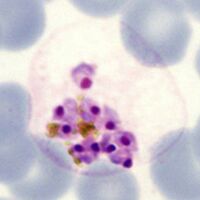Biology of the gametocyte
From haematologyetc.co.uk
Navigation
(click blue highlighted text to return to page)
Malaria main index
>Basic malaria biology
>>This page: Biology of the schizont
| The gametocyte pathway |
The gametocyte is the committed sexual form of the malarial parasite. Gametocytes have either male or female form (a higher percentage are female). However this form should probably be considered as “dormant” in blood, since they do not develop further until ingested by a mosquito - following a temperature drop in the mosquito foregut the gametocytes then rapidly form the active sexual form – either a single female gamete or 8 male gametes (see section on re-infection of the mosquito).
Generally male gametocytes (microgametocytes) are smaller then the female form (macrogametocytes). This is shown in the image below:
| Morphological features and relevance |
(1) P.falciparum – typically elongated or “banana” shaped forms
(2) P.malariae – typically small and neat rounded forms
(3) P.vivax – typically very large and often irregular
(4) P.ovale – typically sightly enlarged and may be fimbriated
→ Click for clinical images illustrating schizont development
| Relevance of schizonts to clinical biology |
The release of merozoites from schizonts exposes the body to large amounts of free parasite antigens no longer contained within the erythrocytes - the result is an immune response causing high fever and illness symptoms. In some cases the development of parasites is synchronous so that all schizonts mature and release their merozoites at the same time - although rarely seen now, this pattern of development may produce a pattern of remitting fever with a distinct periodicity depending on species: underlying the older descriptive terms tertian or quartan malaria.
The gametocyte is the committed sexual form of the malarial parasite. Gametocytes have either male or female form (a higher percentage are female). However this form should probably be considered as “dormant” in blood, since they do not develop further until ingested by a mosquito - following a temperature drop in the mosquito foregut the gametocytes then rapidly form the active sexual form – either a single female gamete or 8 male gametes. The morphological development of gametocytes is progressive as trophozoites that are committed to this stage progressively enlarge and become solid, mostly or entirely filling the erythrocyte with granular pigment, and a single or patchy distribution of chromatin. Generally male gametocytes (microgametocytes) appear smaller than female gametocytes (macrogametocytes). Some characteristic species appearances are present at the gametocyte stage that can contribute to species recognition. For the four major malarial species these are: P.falciparum – typically elongated or “banana” shaped forms P.malariae – typically small and neat rounded forms P.vivax – typically very large and often irregular P.ovale – typically sightly enlarged and may be fimbriated
Clinical note Following treatment of malaria these forms may persist (depending on the nature of the treatment) particularly in the first week but sometimes up to 28 days (unlike the asexual forms that generally disappear more rapidly).
